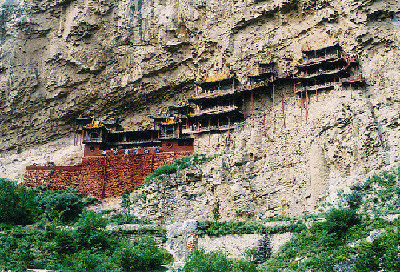

 |
| Hanging Temple in Hunyuan county, Shanxi province |
Datong, the northernmost city of Shanxi province, lies at the northeastern edge of a loess plateau and is one of Chinese first group of 24 historical, cultural cities. It borders the Mongolia autonomous region to the north, the city of Shuozhou, Shanxi province to the west, Xinzhou, Shanxi province to the south and Hebei province to the east.
It covers a 14,113-square-kilometer area with an average elevation of 700 to 1,400 meters, the highest place being Huangyangjian, the main peak of the Liulengshan Mountains, at 2,420 meters, and the lowest, Ranzhuang River in Lingqiu county, at 558 meters.
The city has a population of more than three million, with around 60 percent of them in agriculture. The Han ethnic group account for 99.6 percent, but it also has Mongolians, Man, Hui, Zang, Miao, and Koreans ethnic groups.
Datong has long been famous for its coal, with proven reserves of 37.69 billion tons of good quality coal with a high calorific value. In addition to coal, the city has other mineral resources, including iron, copper, aluminum, zinc, phosphorus, Limestone, mica, graphite, marble and granite.
And it has 20,000 historical sites, including the Yungang Grottoes, which date back to the Northern Wei Dynasty (386–557), Huayan Monastery, architecture from the Liao Dynasty (916–1125), Nine-Dragon Wall, the Xujiayao site of early Homo sapiens remains, Hengshan Mountain, the hanging cliff temple near Mount Heng, the brick tower of Yuanjue Temple, Ciyun Temple, Jueshan Temple, the site of the Battle of Baideng between the Western Han Dynasty (206BC-AD24) and the Hun in 200 BC, a Kwan-Yin Temple, and part of the Great Wall, with 60 national and provincial cultural relics protection units.